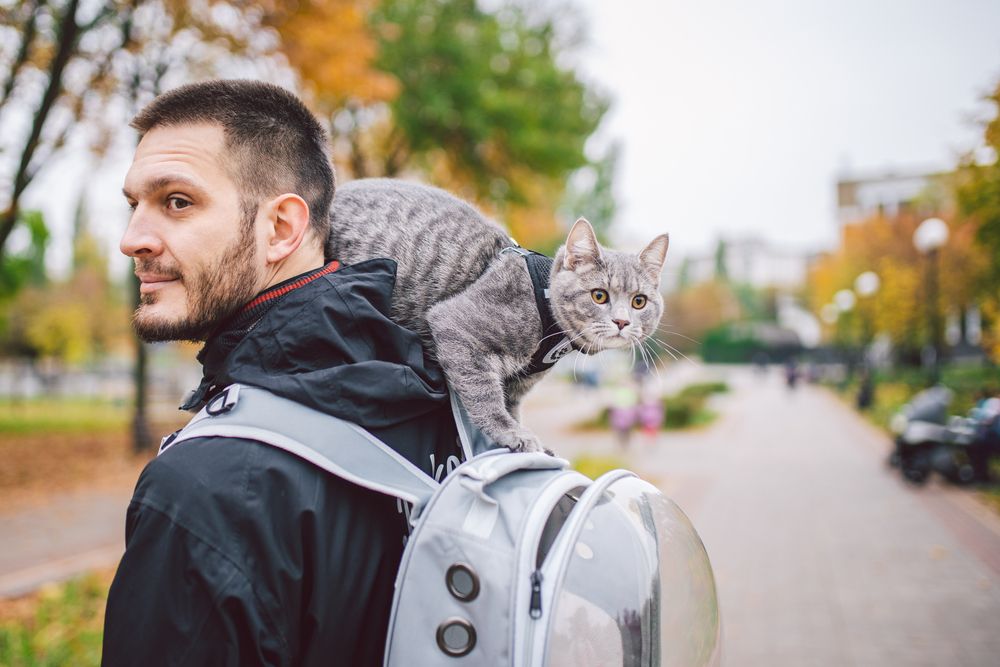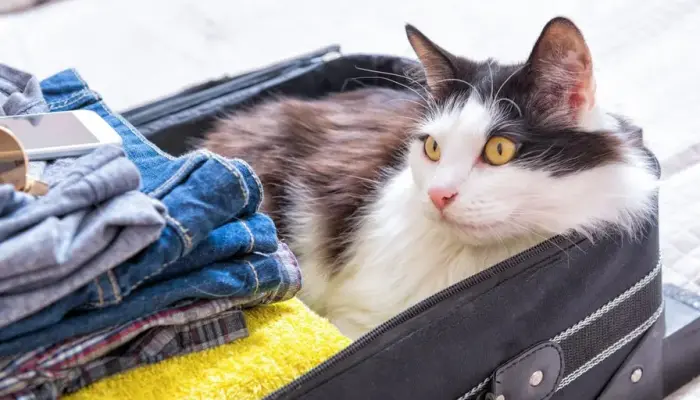Planning a trip with your furry companion? By following these tips, you can ensure the comfort and safety of your cat during travel by any means of transportation.
5 Golden Rules for Traveling with a Cat

- Carrier. Choose a spacious carrier where your cat can stretch and turn around. Place a soft mat or cushion on the bottom and secure it to prevent slipping. Bring a warm blanket and your pet's favorite toys for cooler weather to make them feel cozy and secure.
- Sedatives. Certified sedative drugs can help your cat remain calm in stressful travel situations. Consult with a veterinarian and choose the appropriate dosage. Sedatives can be in the form of drops, pills, sprays, or collars. They act gently, are not addictive, and help the animal cope with unfamiliar noise, light, and other travel factors.
- Documents. Make sure your cat has all necessary documents compliant with the legislation of the country you are traveling to. A veterinary passport and up-to-date vaccinations, including rabies, are mandatory. Without a complete set of documents, you may encounter problems at the border.
- First Aid Kit for Cats. In addition to sedatives, you'll need bandaging materials, antiseptics, ointment or spray for wound healing, antihistamines, a thermometer, eye drops, and remedies for upset stomach. Although it's unlikely they'll be needed, it's better to be prepared just in case.
- Cat's Luggage. In addition to the carrier, you will need a litter box, bowls for food and water, a supply of dry food (familiar to the cat), clean non-carbonated water, waterproof diapers, and double-sided tape to secure the bedding in the carrier.
Now let's look at the specifics of traveling with a cat by different modes of transportation, to make the journey as comfortable as possible for both the pet and you.
Traveling with a Cat by Train

The train is considered one of the most convenient modes of transport for pets. Here are a few tips for a comfortable journey with a cat by train:
- Check the animal transportation rules of the railway company. You may need to purchase a special travel document.
- If your cat is skittish, try to choose a compartment where it will feel calm and cozy, and from which it is harder to escape. In a sleeper car with constant people movement, the cat may get nervous.
- If the cat refuses to eat, do not insist, but regularly offer it water.
- Let the cat out of the carrier and allow it to walk around using a harness. Cats in trains usually prefer to sleep not in carriers, but next to their owners.
- Place the carrier on a flat surface across the direction of travel to prevent it from falling.
Traveling with a Cat by Plane

If you are flying with your cat, consider the following tips:
- Check the pet transportation rules of the chosen airline. Try to choose flights with minimal layover time.
- During the flight, the animal must remain in the carrier, so accustom your cat to it at least 5 days before the trip.
- Ensure your cat has enough food, water, and necessary medications.
- Verify that all necessary documents are in place.
- Before the flight, place the carrier with the animal in a cool, dark, and quiet place.
Traveling with a Cat by Bus

This is one of the less comfortable ways to travel with a cat, as buses have limited space, and the carrier must be held in your hands or placed under the front seat.
- If your pet is prone to motion sickness, avoid feeding it before the trip.
- Each bus company has its own pet transportation rules. Check them with the carrier.
- Typically, there are no special requirements for carriers. You can use a soft bag carrier or a special backpack with a window.
- It is not recommended to travel with a cat in the bus cabin without a carrier, on a seat or in your arms. A frightened animal can behave unpredictably and harm itself or others.
Traveling with a Cat by Car

Gradually accustom your pet to the car. Start by sitting with it in the turned-off vehicle, then take short trips around the neighborhood. Reward your cat with a treat after a successful journey.
- Stop to allow the cat to walk around and use the litter box. Remember: the optimal time in the carrier is 6 hours.
- Make sure the chosen carrier is well-ventilated, large enough for the cat to freely sit, lie down, and turn around, but at the same time compact for its protection.
- Secure the carrier with seat belts to prevent it from sliding and bouncing on bumps.
- Bring your cat's favorite toys along.
- Never leave it alone in a closed car!
Frequently Asked Questions
How to travel with a cat over long distances?
Before departure, definitely visit a veterinarian and give your pet a sedative. Purchase a quality carrier and take a sufficient supply of food.
How to calm a cat during a trip?
Use special sedative drugs before and during the trip. Offer your pet its favorite toys and treats.
Is it possible to travel with a cat without a carrier?
It is not recommended. A carrier ensures the safety of your cat and those around during the trip. Without it, a frightened animal can behave unpredictably and cause harm to itself or others.
How to accustom a cat to a carrier?
Start the acclimatization process 5-7 days before the trip. Place the carrier in the house, put inside the cat's favorite toys and treats. Gradually increase the time it spends inside. Praise and reward your pet for calm behavior in the carrier.
What documents are needed for traveling with a cat?
A veterinary passport with current vaccinations, including rabies, is mandatory. Additional documents may be required for international trips; verify the requirements in advance.
By following these tips, you can ensure the safety and comfort of your cat during travel by any mode of transportation. Have a great trip!
